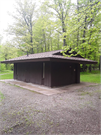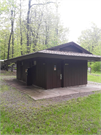Property Record
Bass Loop
Architecture and History Inventory
| Historic Name: | Bass Loop Comfort Station |
|---|---|
| Other Name: | Shower House 3 |
| Contributing: | |
| Reference Number: | 245905 |
| Location (Address): | Bass Loop |
|---|---|
| County: | Taylor |
| City: | |
| Township/Village: | Cleveland |
| Unincorporated Community: | |
| Town: | 32 |
| Range: | 3 |
| Direction: | W |
| Section: | 25 |
| Quarter Section: | SW |
| Quarter/Quarter Section: | SW |
| Year Built: | 1968 |
|---|---|
| Additions: | |
| Survey Date: | 2021 |
| Historic Use: | bath house |
| Architectural Style: | |
| Structural System: | Balloon Frame |
| Wall Material: | Wood |
| Architect: | |
| Other Buildings On Site: | Y |
| Demolished?: | No |
| Demolished Date: |
| National/State Register Listing Name: | Not listed |
|---|---|
| National Register Listing Date: | |
| State Register Listing Date: |
| Additional Information: | The four comfort stations are the most distinctive buildings in the campground. The style of the comfort stations is analogous to the Mid-century Modern Contemporary style house (c.1945-1990), a style influenced by Frank Lloyd Wright’s Usonian houses and characterized by a low-pitched gabled roof with widely overhanging eaves, windows in the gable ends, broad expanses of uninterrupted wall surface, screening fences, and obscured entry doors. The Chippewa Campground comfort stations were all built according to Region 9’s 1969 design drawing for a “Comfort Station,” numbered U-159. They are the “4 Unit with Showers” variation, divided into a men’s side and a women’s side, each side with two stalls (two toilets on the women’s side, a toilet and a urinal on the men’s side), one shower stall, and one sink. A utility closet is located in the center of the building, accessed via a door in the rear elevation. The comfort stations are single-story rectangular buildings (24ft x 13ft) on concrete slab foundations. The exterior is clad in rough-sawn T1-11 plywood sheathing painted brown. Doors to the men’s and women’s rooms are located on the gable ends of the buildings and are solid core doors with a tall narrow window (1ft x 5ft 8in) covered with horizontal wooden louvers. The broad sides of the building have two windows each. The windows on the front are high small (2ft 8in x 1ft 6in) horizontal rectangles with fixed single panes of frosted glass. Horizontal wooden louvers run down the side of the building under the windows. Bulletin boards and shower token dispenser stands are located between the front windows On the back of the building, the widely spaced windows are narrow vertical rectangles of frosted glass (1ft 4in by 4ft 10in), also with horizontal wooden louvers below. The utility door is located between the two vertical windows but is matched to the T1-11 siding and visually inconspicuous. The roof is a low-pitched gable-on-hip with a wide eave overhang. The U-159 design includes options for either asphalt shingle or wood shake roofs. The design also includes two-panel screen walls at the front corners of the building to obscure the men’s and women’s entrance doors, which could be either masonry or wood. This is the sole comfort station in the Bass Loop and is the third of four overall in the recreation area. |
|---|---|
| Bibliographic References: | Jordan, Sarah 2023 Determination of Eligibility and Finding of Effect, Chippewa Recreation Area, Taylor County, Wisconsin. USDA Forest Service Rhinelander, WI |
| Wisconsin Architecture and History Inventory, State Historic Preservation Office, Wisconsin Historical Society, Madison, Wisconsin |


